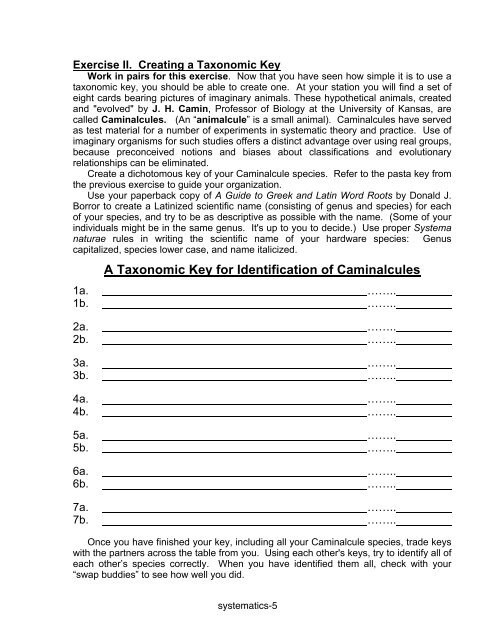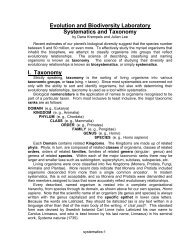Evolution and Biodiversity Laboratory Systematics and Taxonomy
Evolution and Biodiversity Laboratory Systematics and Taxonomy
Evolution and Biodiversity Laboratory Systematics and Taxonomy
You also want an ePaper? Increase the reach of your titles
YUMPU automatically turns print PDFs into web optimized ePapers that Google loves.
Exercise II. Creating a Taxonomic KeyWork in pairs for this exercise. Now that you have seen how simple it is to use ataxonomic key, you should be able to create one. At your station you will find a set ofeight cards bearing pictures of imaginary animals. These hypothetical animals, created<strong>and</strong> "evolved" by J. H. Camin, Professor of Biology at the University of Kansas, arecalled Caminalcules. (An “animalcule” is a small animal). Caminalcules have servedas test material for a number of experiments in systematic theory <strong>and</strong> practice. Use ofimaginary organisms for such studies offers a distinct advantage over using real groups,because preconceived notions <strong>and</strong> biases about classifications <strong>and</strong> evolutionaryrelationships can be eliminated.Create a dichotomous key of your Caminalcule species. Refer to the pasta key fromthe previous exercise to guide your organization.Use your paperback copy of A Guide to Greek <strong>and</strong> Latin Word Roots by Donald J.Borror to create a Latinized scientific name (consisting of genus <strong>and</strong> species) for eachof your species, <strong>and</strong> try to be as descriptive as possible with the name. (Some of yourindividuals might be in the same genus. It's up to you to decide.) Use proper Systemanaturae rules in writing the scientific name of your hardware species: Genuscapitalized, species lower case, <strong>and</strong> name italicized.A Taxonomic Key for Identification of Caminalcules1a. ……..1b. ……..2a. ……..2b. ……..3a. ……..3b. ……..4a. ……..4b. ……..5a. ……..5b. ……..6a. ……..6b. ……..7a. ……..7b. ……..Once you have finished your key, including all your Caminalcule species, trade keyswith the partners across the table from you. Using each other's keys, try to identify all ofeach other’s species correctly. When you have identified them all, check with your“swap buddies” to see how well you did.systematics-5

















